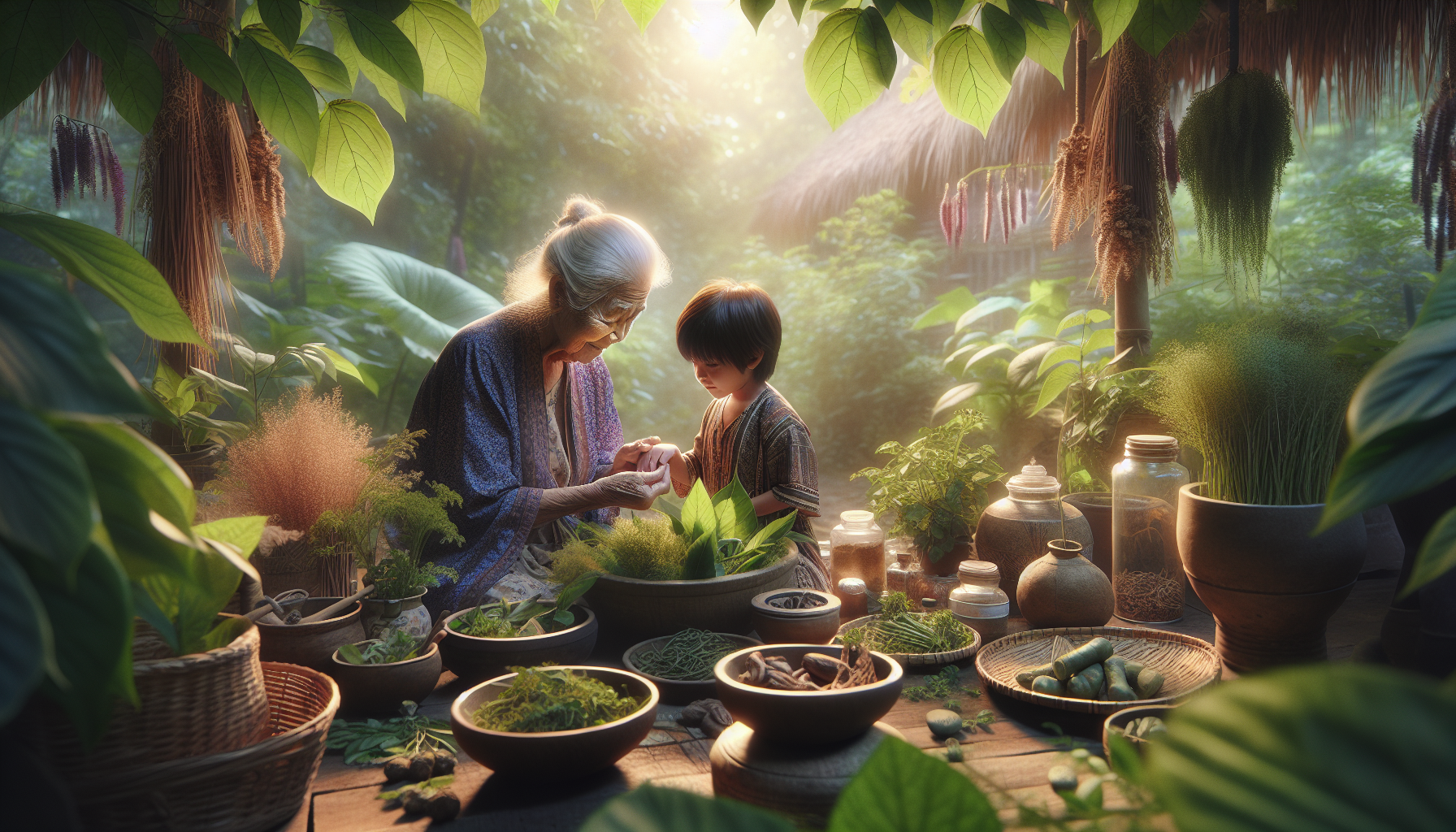In an age where modern medicine often takes center stage, there is a growing movement that calls us back to the wisdom of our ancestors. Imagine a world where the remedies for some of our most pressing health issues don’t come in the form of a pill, but rather from the leaves, roots, and flowers that have been used for generations. Welcome to the fascinating realm of ancestral herbs—a treasure trove of natural wellness waiting to be rediscovered. 🌿
Our journey begins with the understanding that plants have been integral to human survival and well-being for millennia. The use of herbs in traditional healing practices spans cultures and continents, each with its own unique blend of flora that catered to the health needs of its people. By tapping into these time-honored traditions, we are not only embracing natural methods of health and wellness but also connecting with our lineage and heritage. This connection offers us a deeper understanding of who we are and where we come from. It’s a journey that is both personal and universal, as it bridges the gap between past and present.
In this exploration of ancestral herbs, we will delve into the various ways they can be harnessed for health and wellness. From the calming effects of chamomile to the immune-boosting properties of echinacea, each herb carries its own set of benefits that have stood the test of time. We will examine how these plants were traditionally used, and how modern science is beginning to validate their efficacy. Furthermore, we’ll look at the cultural significance of these herbs and how they play a role in rituals and traditions that celebrate the cycle of life. By understanding the historical context and current applications, we can better appreciate the power that lies in these natural remedies.
Moreover, we will explore practical ways to integrate ancestral herbs into your daily life. Whether it’s through herbal teas, tinctures, or topical applications, incorporating these plants into your routine can be both simple and rewarding. We’ll provide guidance on how to identify and source quality herbs, ensuring that you’re getting the most benefit from these potent plants. Additionally, we’ll discuss the importance of sustainability and ethical sourcing, ensuring that our quest for wellness does not come at the expense of the environment or the communities that have cultivated these herbs for generations.
Finally, this article will not only serve as a guide to the practical uses of ancestral herbs but also as an invitation to embark on a journey of self-discovery. By uncovering the herbal practices of your own family lineage, you can create a personalized wellness routine that resonates with your unique heritage. Whether you are looking to manage stress, boost your immune system, or simply connect with your roots, the power of ancestral herbs is a timeless resource that is just waiting to be unlocked. Let this exploration inspire you to delve deeper into the world of natural healing, fostering a greater appreciation for the botanical legacy that is an inherent part of our human story.
The Ancient Wisdom of Ancestral Herbs
Understanding the significance of ancestral herbs involves delving into the profound knowledge and practices of our forebears. These plants have been revered for centuries for their healing properties and spiritual significance. They offer more than just medicinal benefits; they connect us to our lineage, allowing us to harness the wisdom of our ancestors for health and wellness today.
Many cultures around the world have relied on herbs for their healing properties. In traditional Chinese medicine, herbs are used to restore balance and promote wellness. Similarly, Ayurveda, the ancient Indian system of medicine, incorporates a wide array of herbs, such as ashwagandha and turmeric, to treat various ailments and promote longevity. The Mayans and Aztecs of Central America used cacao and vanilla for both culinary and medicinal purposes. Each of these cultures has a rich history that ties their identity to these plants.
Understanding the Benefits
Ancestral herbs offer numerous health benefits, ranging from boosting immunity to reducing stress and anxiety. For instance, herbs like ginseng, used traditionally in Asian cultures, are known for their energy-boosting properties. Chamomile, prevalent in European herbal traditions, is famous for its calming effects and is often used to alleviate insomnia and anxiety.
These herbs work in harmony with the body, often producing fewer side effects than synthetic medications. They are natural, holistic solutions that can support modern health needs without introducing harmful chemicals. Additionally, many of these plants contain antioxidants, which help combat oxidative stress and reduce the risk of chronic diseases such as heart disease and cancer.
Incorporating Ancestral Herbs into Modern Life
Integrating ancestral herbs into your daily routine can be a seamless process. Start by researching your family’s cultural background to identify which herbs were traditionally used by your ancestors. This research can provide insights into their dietary practices, lifestyle, and the specific plants they utilized for health and wellness.
Once you have identified the herbs relevant to your lineage, consider how they can be incorporated into your diet or wellness regimen. Many of these herbs can be consumed in various forms, such as teas, capsules, or extracts. For instance, turmeric can be added to smoothies or dishes for an anti-inflammatory boost, while ginger can be brewed as a tea to aid digestion.
Another approach is to create a small herb garden, allowing you to grow and harvest your ancestral plants. This not only provides a fresh supply of herbs but also fosters a deeper connection with nature and your heritage. As you cultivate these plants, you can reflect on their historical significance and their role in your family’s health traditions.
Practical Steps for Incorporation
- Identify herbs significant to your ancestry and their traditional uses.
- Incorporate these herbs into your diet through teas, cooking, or supplements.
- Consider growing an herb garden to maintain a fresh supply and connect with nature.
- Explore local herbalists or workshops to deepen your understanding and skills.
It’s important to approach the incorporation of these herbs with mindfulness and respect for their cultural origins. Educate yourself about their properties and potential interactions with other medications or conditions. Consulting with a healthcare professional or herbalist can ensure you use these herbs safely and effectively.
The Science Behind Ancestral Herbs
Modern science is beginning to validate the traditional uses of many ancestral herbs, shedding light on their mechanisms of action and potential health benefits. Research has shown that these herbs often contain compounds that can positively impact physiological processes in the body.
For example, curcumin, the active compound in turmeric, has been studied extensively for its anti-inflammatory and antioxidant properties. Studies suggest that curcumin can inhibit the growth of certain cancers, reduce symptoms of depression, and alleviate arthritis pain. Similarly, ginseng has been found to improve cognitive function and enhance immune response.
These findings highlight the potential of ancestral herbs to complement conventional medicine, offering natural alternatives for promoting health and wellness. As more research is conducted, we can expect to gain a deeper understanding of how these herbs interact with the body and how they can be used to address various health concerns.
Research and Development
Scientific advancements have also led to the development of standardized extracts and supplements, ensuring consistent potency and efficacy of herbal products. This has made it easier for individuals to incorporate these herbs into their health routines with confidence. However, it remains crucial to choose high-quality products from reputable sources to avoid contaminants and ensure the best outcomes.
Check out this video on YouTube to learn more about the science of ancestral herbs: The Science of Ancestral Herbs – Nature’s Pharmacy (YouTube Channel). 📺
Herbal Remedies Across Different Cultures
Exploring the use of herbs across various cultures reveals a tapestry of traditional practices and beliefs. Each culture has its unique perspective on health and healing, often rooted in a deep respect for nature and the interconnectedness of all living things.
In Native American traditions, herbs like sage, sweetgrass, and cedar play a vital role in spiritual and healing ceremonies. These plants are used to purify spaces and individuals, fostering a sense of peace and well-being. Similarly, in African traditions, herbs such as kola nut and rooibos are used for their energizing and calming properties, respectively.
By understanding and appreciating these diverse herbal practices, we can expand our knowledge and embrace a more holistic approach to health and wellness. This exploration encourages cultural exchange and mutual respect, promoting a deeper connection to the earth and our shared humanity.
Comparison of Herbal Traditions
| Culture | Herbal Practices | Common Herbs |
|---|---|---|
| Traditional Chinese Medicine | Balance of yin and yang, use of herbal formulas | Ginseng, goji berries, ginger |
| Ayurveda | Dosha balancing, use of herbal powders and teas | Ashwagandha, turmeric, holy basil |
| Native American | Spiritual and medicinal ceremonies, purification | Sage, sweetgrass, cedar |
| African | Herbal tonics and infusions, cultural rituals | Kola nut, rooibos, baobab |
This table provides a snapshot of the rich and varied herbal practices across different cultures. By exploring these traditions, we can discover new ways to incorporate ancestral wisdom into our lives and enhance our health and wellness. Each culture offers unique insights and remedies that can complement our modern approaches, creating a more comprehensive and inclusive understanding of herbal medicine.

Conclusion
Certainly! Here is a comprehensive conclusion for the article titled “Uncover Your Roots: Harnessing the Power of Ancestral Herbs in Your Family Lineage for Health and Wellness”:
—
In conclusion, the exploration of ancestral herbs offers a profound connection to our roots, presenting a unique pathway to enhance our health and wellness. By delving into the traditional knowledge passed down through generations, we not only rediscover the healing properties of these herbs but also strengthen the bond with our cultural heritage. The journey to uncovering these age-old remedies reminds us that nature has always provided solutions to our ailments, waiting to be rediscovered and appreciated in our modern lives.
Throughout this article, we have explored the myriad benefits of integrating ancestral herbs into our daily routines. From improving physical health to fostering emotional well-being, these natural remedies offer a holistic approach to wellness. By learning from our ancestors, we gain insights into sustainable practices that are both environmentally friendly and personally enriching. The importance of preserving this knowledge cannot be overstated, as it holds the key to a healthier future for generations to come.
Understanding the history and traditional uses of these herbs allows us to appreciate their versatility and potency. Whether it is the calming effects of chamomile, the anti-inflammatory properties of turmeric, or the immune-boosting power of echinacea, each herb carries a legacy of healing that has stood the test of time. By integrating these natural solutions into our lives, we embrace a lifestyle that is in harmony with nature and respectful of our lineage.
Moreover, the process of researching and identifying herbs specific to our family lineage can be a rewarding and enlightening experience. It not only empowers us with knowledge but also fosters a sense of belonging and identity. This exploration can lead to greater self-awareness and a deeper understanding of where we come from, providing a foundation for personal growth and wellness.
As we move forward, it is crucial to approach the use of ancestral herbs with mindfulness and respect. Consulting with healthcare professionals and herbalists ensures that we use these remedies safely and effectively. It is also important to source herbs sustainably, supporting ethical practices that protect biodiversity and honor traditional harvesting methods.
We encourage you, our readers, to embark on your own journey of discovery. Research your family’s herbal traditions, experiment with incorporating these herbs into your daily life, and share your findings with others. By doing so, you contribute to a growing community of individuals committed to holistic health and cultural preservation. 🌿
In conclusion, embracing ancestral herbs is more than just a wellness trend; it is a return to our roots, offering us a roadmap to a healthier and more balanced life. Let this article serve as a starting point for your exploration and application of this invaluable knowledge. We invite you to share your experiences, insights, and any new discoveries you make along the way. Together, we can cultivate a future where the wisdom of our ancestors continues to thrive, enriching our lives and the world around us.
Thank you for joining us on this enlightening journey. We look forward to hearing your thoughts, experiences, and any questions you might have in the comments below. Feel free to share this article with friends and family, encouraging them to uncover the power of ancestral herbs in their own lives. 🌱
For further reading and exploration, consider visiting these reliable sources: National Center for Complementary and Integrative Health, American Herbalists Guild, and Herb Society of America.
—
Gabriel is a visual storyteller and symbolic naturalist whose creations explore the veiled ecologies and ancestral ties between humans and the living world, as echoed through myth and memory. With a sensitivity attuned to the sacred, Gabriel unveils the ancient choreography of plant, animal, and spirit — a realm where forests spoke in signs, rivers kept secrets, and every flower bore a forgotten name.
His path winds through the esoteric — tracing the rituals of forest sages, the herbal codes of ancestral healers, and the silent agreements that once guided human life in deep reciprocity with nature. From moss-covered shrines to twilight groves, Gabriel’s work reveals relationships once vital, now buried beneath layers of modern detachment.
With a foundation in visual design and the aesthetics of ancestral wisdom, Gabriel weaves storytelling into sacred ecology. His work doesn’t just depict — it channels. Drawing from myth, mysticism, and lost herbal traditions, he crafts images and narratives that pulse with the old knowing: that nature is not scenery, but kin and teacher.
Through collections of symbolic visuals, myth-rooted studies, and intuitive reflections, Gabriel invites others to rekindle forgotten senses — to listen not only with ears, but with intuition, memory, and reverence.
His work is a tribute to:
-
The mythic language of trees, stones, and roots
-
Forgotten pacts between healers and the wild
-
The sacred intelligence in nature’s unseen patterns
Whether you walk with the lore of plants, dream with the rhythms of the earth, or simply feel the call of something older in the wind through the leaves, Gabriel welcomes you into a space where symbolism, spirit, and wild nature entwine — one myth, one leaf, one vision at a time.





